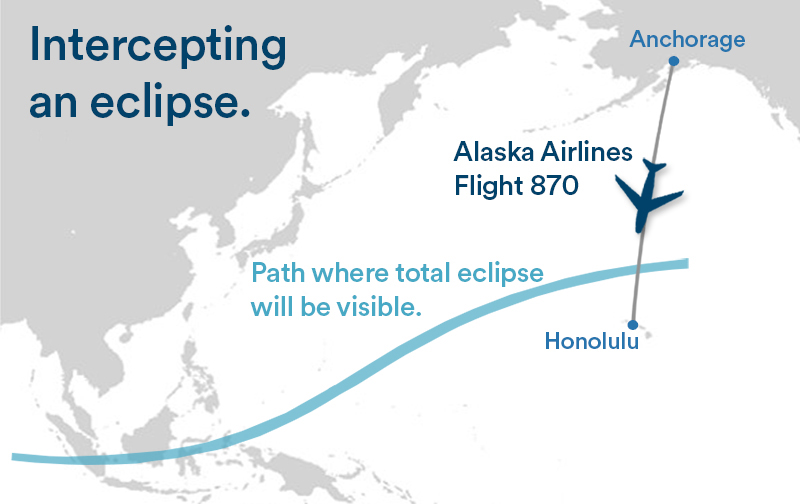Chasing the shadow of the moon: To intercept eclipse, Alaska Airlines adjusts flight plan to delight astronomers
Share
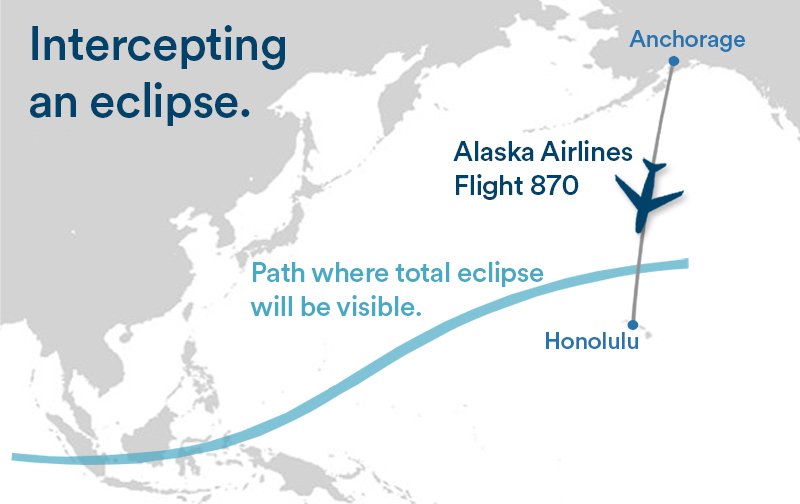
There’s no luck in physics.
When the sun and the moon and the Earth aligned this week, an Alaska Airlines jet was in the right place at the right time to catch the total solar eclipse.
The March 8 rendezvous over the Pacific Ocean was not luck, but a precisely planned equation. The calculations began a year ago. The only variable was the plane.
In window seat 32F, Joe Rao was one of the dozen astronomers and veteran “eclipse chasers” among the 181 passengers onboard, gazing out oval windows as the moon blocked the sun for nearly two minutes.
He’s an associate astronomer at the American Museum of Natural History’s Hayden Planetarium (where astrophysicist Neil deGrasse Tyson is director). About a year ago, Rao discovered that Alaska Airlines Flight 870 from Anchorage to Honolulu would intersect the “path of totality” – the darkest shadow of the moon as it passes over the Earth.
But the flight’s normally scheduled departure time would have been 25 minutes too early, missing the grand spectacle.
Rather than attempt to move the sun or the moon or the Earth, Rao called Alaska Airlines.
Alaska decided to move the plane.
“It’s an unbelievably accommodating gesture,” said Mike Kentrianakis, solar eclipse project manager for the American Astronomical Society, who was in seat 6F. “Not only is Alaska Airlines getting people from Point A to Point B, but they’re willing to give them an exciting flight experience. An airline that’s actually talking to their people – and listening! That’s customer service at its best. It’s become personal.”
UMBRAPHILES, UNITE!
Rao and Kentrianakis are among a tight-knit community of self-described eclipse geeks. These “umbraphiles” (after the umbra, the dark shadow cone of the moon that sweeps across the surface of the Earth) traverse the globe in search of solar eclipses.
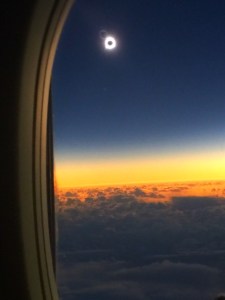
“We are all veteran eclipse chasers who have traveled around the world to ‘bask in the shadow of the moon’ for a few precious minutes,” Rao said.
In seat 7F was Craig Small, a semi-retired astronomer from the Hayden Planetarium. This was his 31st total eclipse, making him one of the “Big 4” eclipse viewers in the world. He brought along his lucky eclipse flag, which has accompanied him on every viewing expedition since 1973 – and he’s never missed seeing an eclipse.
“I’m not one for hyperbole, but you don’t just see an eclipse, you experience it with every fiber of your being,” Small said. “It is the most spectacular naturally occurring event that anyone could witness in their lifetime.”
In seat 8F was Dan McGlaun, who brought 200 pairs of special filtered glasses to hand out to everybody on the plane, so they can watch the sun during all phases of the eclipse. (During the nearly two minutes of “totality,” McGlaun says it’s safe to take off the glasses and watch.)
“You can’t be doing something that’s this exciting and not give everybody onboard the chance to at least participate,” said McGlaun, who viewed his 12th total eclipse.
In seat 15F, experiencing his 15th total eclipse, was Bob Stephens, a CPA turned amateur astronomer who will film the eclipse with his GoPro, while also taking photos with a couple of handheld cameras.
“For people who have seen a total solar eclipse, these are the most spectacular events they will see in their life,” Stephens said. “That’s why people start chasing them – you have to see another.”
Up front in first class, Evan Zucker was in seat 1F and his wife Paula Eisenhart was right behind him in 2F – both window seats. As totality ended and “third contact” occured – the time when the moon starts to move off the sun – Zucker pressed play on his iPhone and listened to The Beatles’ “Here Comes the Sun.”
Flying 500 mph at 35,000 feet, Alaska Flight 870 intercepted the eclipse 695 miles north of Honolulu. The moon shadow itself is oval, 68 miles wide by 500 miles long. It swept across the surface of the Earth at 8,000 mph on a narrow path from Southeast Asia across the Pacific Ocean. For those on the plane, beginning at 5:35 p.m., the sun was completely blocked by the black disc of the moon for 1 minute 53 seconds.
“In the few minutes leading up to the total phase – much like ‘curtain time’ at a Broadway show – the light in the cabin will begin to slowly diminish as the waning crescent of the sun is gradually extinguished,” Rao said.
THE PLAN COMES TOGETHER
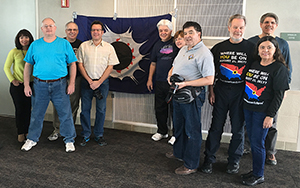
The planning for this moment started immediately after the last total eclipse – March 20, 2015 – when Rao was still celebrating. When Rao examined the path of this March 8, 2016 eclipse, he realized it would be visible only from parts of Indonesia and Micronesian islands – during monsoon season, which increases the chances of a rainout.
As he traced the narrow belt as it arced over the Pacific Ocean, he wondered if any commercial flights crossed the path. After some quick online research, he found Alaska Airlines Flight 870.
Dr. Glenn Schneider of the University of Arizona’s Steward Observatory (a veteran of 32 eclipses, who will be viewing this one in Indonesia), worked out the suggested flight plans, and Rao presented them to Alaska Airlines to show he was serious.
Chase Craig, Alaska’s director of onboard brand experience, found the right people to make it happen.
Alaska’s fleet director, Captain Brian Holm, reviewed the proposed flight path and possible in-route changes to optimize for the eclipse. The schedule planning team pushed back the departure time by 25 minutes, to 2 p.m.
On the day of the flight, Dispatch will develop the specific flight plan, to find the most efficient route and account for weather and wind. Maintenance and maintenance control will help make sure the plane is ready to go – they even washed all the windows on the right side of the plane.
Captain Hal Andersen also coordinated with Oceanic Air Traffic Control, to make them aware that the flight might require a few more tactical changes then normal.
“The key to success here is meeting some very tight time constraints – specific latitudes and longitudes over the ocean,” Andersen said. “With the flight management computer, it’s a pretty easy challenge, but it’s something we need to pay very close attention to. We don’t want to be too far ahead or too far behind schedule.”
CELEBRATING CUSTOMERS’ PASSIONS
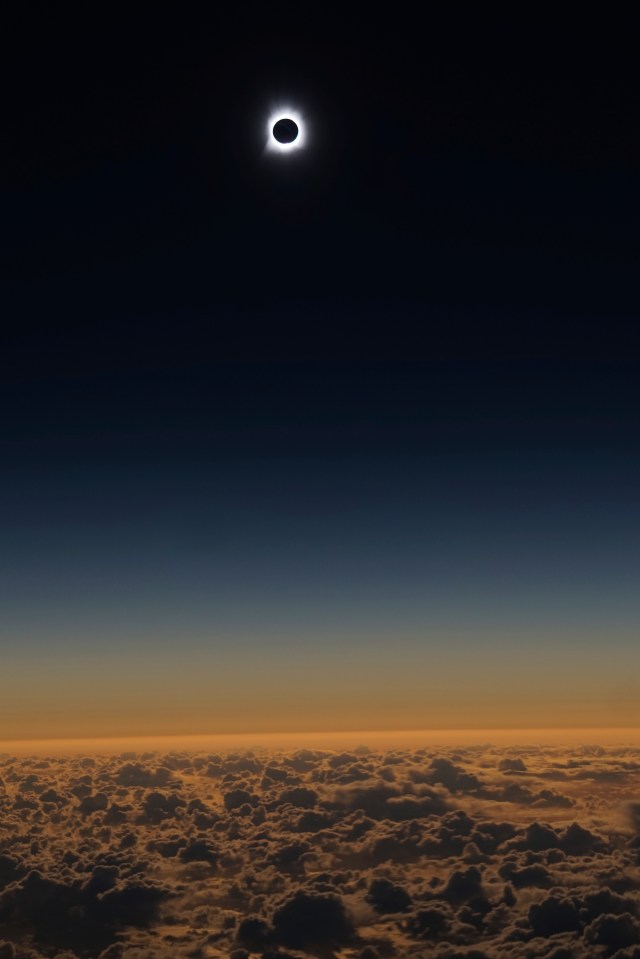
For the Alaska Airlines employees who worked to accommodate the flight change, it’s about brightening someone’s day and going the extra mile to create a unique experience.
“We recognize our customer’s passions,” Craig said. “Certainly we can’t change flight plans for every interest, but this was a special moment, so we thought it was worth it. Now we have a plane full of customers who will be treated to a special occurrence.”
After Alaska confirmed the flight plan would be altered to rendezvous with the eclipse, Rao spread the word to a few astronomical societies. About a dozen people booked seats for the opportunity to see a total solar eclipse from an aircraft. Some of them canceled plans in Indonesia so they could be on the plane.
Other passengers who are simply flying from Anchorage to Honolulu were in for a surprise.
“We on the Alaska Airlines flight will be the last people in the world to see this eclipse – nobody will see it after us,” Small said.
Since they’re flying from the 49th state to the 50th state, Kentrianakis calls this the “almost-Great American Eclipse.” It’s a sneak preview of “The Great American Eclipse” next year – Aug. 21, 2017 – which will be the first total solar eclipse to sweep across the entire United States since 1918. It’s expected to be one of the biggest news stories of 2017.
Umbraphiles around the world are already making plans.
NEW: WATCH THE ECLIPSE VIDEO
Video by Mike Kentrianakis/American Astronomical Society
FOLLOW THE FLIGHT
Tuesday, March 8, 2016
Alaska Airlines flight 870, Anchorage – Honolulu
Departs: 2 p.m. Alaska Standard Time
Arrives: 7:16 p.m. Hawai’i Standard Time
Track the flight at FlightAware.com.
Resources for the eclipse on Aug. 21, 2017:
